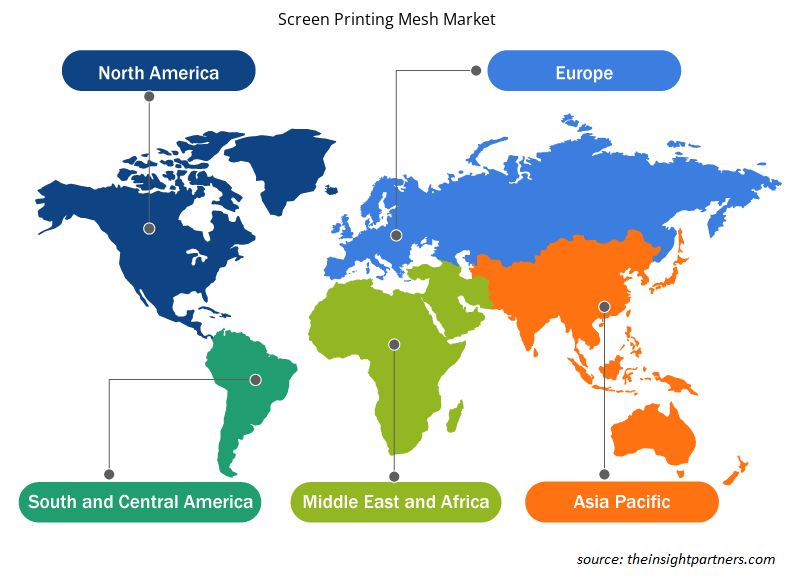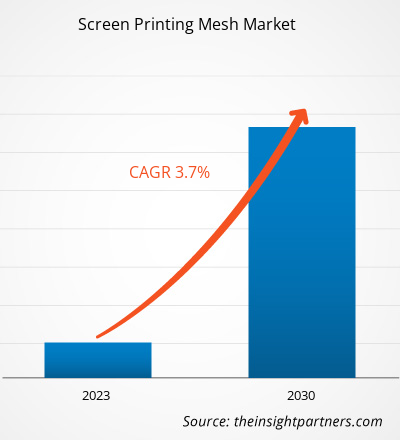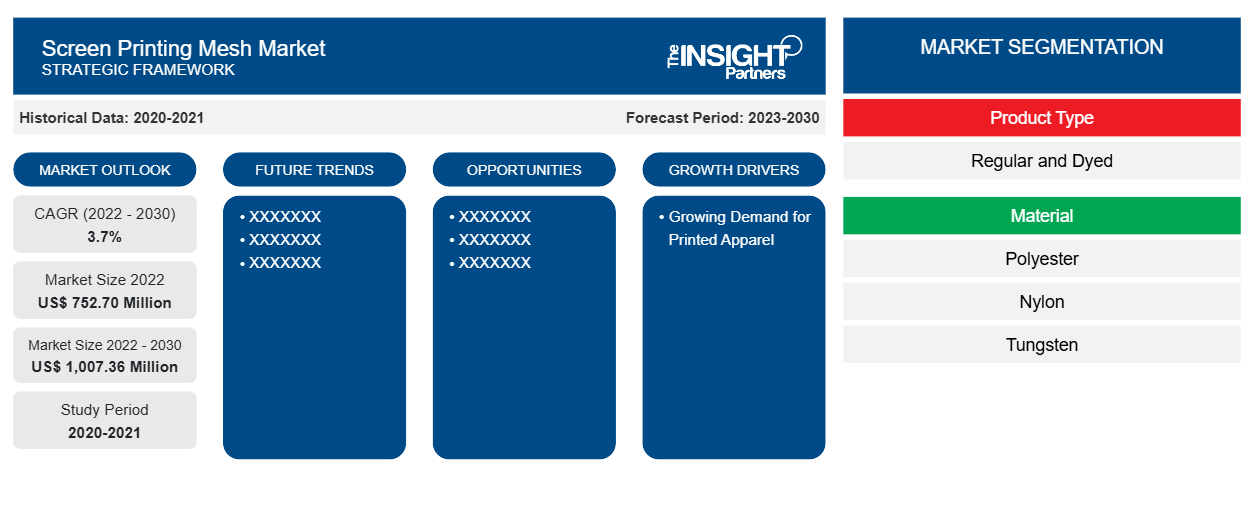[Informe de investigación] Se espera que el tamaño del mercado de mallas de serigrafía crezca de US$ 752,70 millones en 2022 a US$ 1.007,36 millones en 2030; se estima que registrará una CAGR del 3,7% de 2022 a 2030.CAGR of 3.7% from 2022 to 2030.
Perspectivas del mercado y opinión de analistas:
La malla de serigrafía se refiere a la tela o material tejido que se estira firmemente sobre un marco para crear una pantalla para serigrafía. La malla de serigrafía viene en diferentes cantidades de malla. Las mallas de serigrafía de diferentes tamaños de malla ofrecen ventajas específicas durante el proceso de serigrafía. Están hechas de materiales como nailon, poliéster, acero inoxidable, tungsteno y otros. La malla de serigrafía de poliéster es un material ampliamente utilizado debido a su excepcional versatilidad y durabilidad. Las mallas de serigrafía se utilizan en textiles, electrónica y electricidad, vidrio, cerámica y muchas otras industrias. En la industria electrónica y eléctrica, la malla de serigrafía se utiliza para imprimir en una variedad de sustratos, como placas de circuitos, paneles solares, circuitos flexibles y pantallas. Ha habido una creciente demanda de ropa personalizada y personalizada, y los consumidores buscan artículos únicos e individualizados que reflejen su estilo personal. Este factor está impulsando significativamente el crecimiento del mercado mundial de mallas de serigrafía .electricals, glass, ceramics, and many other industries. In the electronics & electricals industry, screen printing mesh is used to print on a variety of substrates, such as circuit boards, solar panels, flexible circuits, and displays. There has been a growing demand for personalized and customized clothing, with consumers seeking unique and individualized items that reflect their personal style. This factor is significantly driving the global
Factores impulsores del crecimiento y desafíos:
La creciente tendencia de la ropa estampada está impulsando la demanda de mallas serigráficas en la industria de la confección. En los últimos años, ha habido una tendencia creciente hacia la ropa estampada, ya que los consumidores buscan artículos únicos e individualizados que reflejen su estilo. Esta tendencia ha impulsado la demanda de mallas serigráficas en la industria de la confección, ya que permiten la impresión precisa y de alta calidad de diseños personalizados en una amplia gama de telas y materiales. Además, los productos promocionales se están volviendo cada vez más populares a medida que las empresas buscan formas rentables de promocionar su marca. La malla serigráfica es un componente clave para crear artículos promocionales llamativos y de alta calidad. Muchas empresas y organizaciones utilizan artículos impresos a medida, como camisetas, bolsos y gorras, para promocionar su marca o mensaje. La malla serigráfica permite la impresión rentable y de alta calidad de estos productos promocionales en grandes cantidades. A medida que más empresas recurran a los productos promocionales como estrategia de marketing, la demanda de mallas serigráficas seguirá aumentando. Sin embargo, los avances tecnológicos en la industria de la impresión pueden suponer un desafío para la mayor expansión del mercado de mallas serigráficas a pesar de su potencial de crecimiento. A medida que las tecnologías de impresión digital continúan mejorando, ofrecen una alternativa viable a la malla de serigrafía para muchas aplicaciones. La impresión digital permite tiempos de entrega más rápidos, mayor flexibilidad en el diseño y la capacidad de imprimir en una gama más amplia de materiales. Este factor dificulta la demanda de mallas de serigrafía.
Personalice este informe según sus necesidades
Obtendrá personalización en cualquier informe, sin cargo, incluidas partes de este informe o análisis a nivel de país, paquete de datos de Excel, así como también grandes ofertas y descuentos para empresas emergentes y universidades.
-
Obtenga las principales tendencias clave del mercado de este informe.Esta muestra GRATUITA incluirá análisis de datos, desde tendencias del mercado hasta estimaciones y pronósticos.
Segmentación y alcance del informe:
El “Mercado global de mallas para serigrafía” está segmentado en función del tipo de producto, el material y la aplicación. Según el tipo de producto, el mercado de mallas para serigrafía se segmenta en regular y teñido. Según el material, el mercado de mallas para serigrafía se segmenta en poliéster, nailon, tungsteno, acero inoxidable y otros. Según la aplicación, el mercado de mallas para serigrafía se segmenta en textiles, electrónica y electricidad, vidrio y cerámica, y otros. Geográficamente, el mercado está segmentado en América del Norte (EE. UU., Canadá y México), Europa (Alemania, Francia, Italia, Reino Unido, Rusia y el resto de Europa), Asia Pacífico (Australia, China, Japón, India, Corea del Sur y el resto de Asia Pacífico), Oriente Medio y África (Sudáfrica, Arabia Saudita, Emiratos Árabes Unidos y el resto de Oriente Medio y África) y América del Sur y Central (Brasil, Argentina y el resto de América del Sur y Central).electricals, glass and ceramics, and others. Geographically, the market is segmented into North America (the US, Canada, and Mexico), Europe (Germany, France, Italy, the UK, Russia, and the Rest of Europe), Asia Pacific (Australia, China, Japan, India, South Korea, and the Rest of Asia Pacific), the Middle East & Africa (South Africa, Saudi Arabia, the UAE, and the Rest of Middle East & Africa), and South & Central America (Brazil, Argentina, and the Rest of South & Central America).
Análisis segmental: Analysis:
Según el tipo de producto, el mercado de mallas de serigrafía se segmenta en regular y teñido. El segmento regular tuvo una mayor participación de mercado en 2022. La malla de serigrafía regular es un componente fundamental y a menudo subestimado en la impresión y la producción textil. La malla de impresión elaborada con materiales de primera calidad, como poliéster y nailon, sirve como un lienzo modesto sobre el que se expresan diseños y patrones intrincados. Su importancia radica en su capacidad para actuar como una pizarra en blanco, asegurando que los colores y detalles de la impresión final permanezcan fieles a la obra de arte original. Según el material, el mercado de mallas de serigrafía se segmenta en poliéster, nailon, tungsteno , acero inoxidable y otros. La participación de mercado de mallas de serigrafía para el segmento de poliéster fue notable en 2022. La malla de serigrafía de poliéster es un material vital y ampliamente utilizado en la serigrafía, apreciado por su excepcional versatilidad y durabilidad. El poliéster, un polímero sintético, sirve como base para esta malla, y sus cualidades inherentes lo convierten en una opción ideal para una amplia gama de aplicaciones de impresión. Una de las características destacadas de la malla de serigrafía de poliéster es su resistencia y resiliencia. Según la aplicación, el mercado de mallas para serigrafía se segmenta en textiles, electrónica y electricidad, vidrio y cerámica, entre otros. La participación de mercado de las mallas para serigrafía en el segmento de textiles fue notable en 2022. La malla para serigrafía se ha convertido en una herramienta esencial en la industria textil, ofreciendo una variedad de beneficios que la convierten en una opción ideal para imprimir diseños en telas. La malla está hecha de un material de alta calidad que es duradero y flexible, lo que permite estirarla sobre un marco sin perder su forma o integridad. Esto facilita la creación de una superficie lisa y uniforme para la impresión, lo que garantiza que cada detalle del diseño se capture con precisión. Una de las principales ventajas de la malla para serigrafía es su capacidad para producir diseños precisos y detallados, incluso en patrones o telas complejos.
Análisis regional:
El mercado de mallas para serigrafía está segmentado en cinco regiones clave: América del Norte, Europa, Asia Pacífico, América del Sur y Central, y Oriente Medio y África. Asia Pacífico dominó el mercado mundial de mallas para serigrafía, y el mercado regional representó aproximadamente 300 millones de dólares estadounidenses en 2022. América del Norte también es un contribuyente importante, ya que posee una parte significativa de la participación en el mercado mundial de mallas para serigrafía. Se espera que el mercado de América del Norte alcance más de 250 millones de dólares estadounidenses en 2030. Se espera que Europa registre una CAGR considerable de más del 3% entre 2022 y 2030. El mercado de mallas para serigrafía de Asia Pacífico, por país, está segmentado en Australia, China, India, Japón, Corea del Sur y el resto de Asia Pacífico. El mercado está impulsado por factores como la creciente demanda de prendas impresas y la creciente popularidad de los productos promocionales. La demanda de mallas para serigrafía en Asia Pacífico está relacionada con la industrialización y el crecimiento de la producción textil en la región. En el marco de los Objetivos de Desarrollo Sostenible 2030, el Banco Asiático de Desarrollo ha planificado construir infraestructuras resilientes, promover la industrialización inclusiva y sostenible y fomentar la innovación en la región de Asia y el Pacífico, que es el principal centro de la industria textil y está formada por países como China, India y Bangladesh, importantes productores de textiles. El aumento del número de fabricantes textiles en países como China, India, Vietnam y Bangladesh aumenta aún más la necesidad de mallas para serigrafía.
Desarrollos industriales y oportunidades futuras:
A continuación se enumeran varias iniciativas adoptadas por los actores clave que operan en el mercado de mallas de serigrafía:
- En marzo de 2022, Sefar amplió su gama de mallas para serigrafía SEFAR PME. Estas nuevas mallas se mostraron en FESPA 2022. Los nuevos tejidos Sefar Open Mesh son SEFAR PME 59/150-48Y PW y SEFAR PME 75/190-40W/Y PW.
Impacto del COVID-19:
La pandemia de COVID-19 afectó a casi todas las industrias en varios países. Los confinamientos, las restricciones de viaje y los cierres de empresas en América del Norte, Europa, Asia Pacífico (APAC), América del Sur y Central (SAM) y Oriente Medio y África (MEA) obstaculizaron el crecimiento de varias industrias, incluida la industria de productos químicos y materiales. El cierre de las unidades de fabricación perturbó las cadenas de suministro globales, las actividades de fabricación, los cronogramas de entrega y las ventas de productos esenciales y no esenciales. Varias empresas informaron retrasos en las entregas de productos y una caída en las ventas de sus productos en 2020. Debido a la recesión económica inducida por la pandemia, los consumidores se volvieron cautelosos y selectivos en las decisiones de compra. Los consumidores redujeron significativamente las compras no esenciales debido a los menores ingresos y las perspectivas de ganancias inciertas, especialmente en las regiones en desarrollo. Muchos fabricantes de mallas de serigrafía enfrentaron una disminución de las ganancias debido a la reducción de la demanda de los consumidores durante la fase inicial de la pandemia. Sin embargo, a fines de 2021, muchos países estaban completamente vacunados y los gobiernos anunciaron la relajación de ciertas regulaciones, incluidos los confinamientos y las prohibiciones de viaje. La gente comenzó a viajar a diferentes lugares, lo que aumentó la demanda de mallas de serigrafía. Todos estos factores impactaron positivamente en el crecimiento del mercado de mallas de serigrafía en diferentes regiones.
Perspectivas regionales del mercado de mallas para serigrafía
Los analistas de Insight Partners explicaron en detalle las tendencias y los factores regionales que influyen en el mercado de mallas para serigrafía durante el período de pronóstico. Esta sección también analiza los segmentos y la geografía del mercado de mallas para serigrafía en América del Norte, Europa, Asia Pacífico, Oriente Medio y África, y América del Sur y Central.

- Obtenga datos regionales específicos para el mercado de mallas para serigrafía
Alcance del informe de mercado de mallas para serigrafía
| Atributo del informe | Detalles |
|---|---|
| Tamaño del mercado en 2022 | US$ 752,70 millones |
| Tamaño del mercado en 2030 | US$ 1.007,36 millones |
| CAGR global (2022-2030) | 3,7% |
| Datos históricos | 2020-2021 |
| Período de pronóstico | 2023-2030 |
| Segmentos cubiertos |
Por tipo de producto
|
| Regiones y países cubiertos |
América del norte
|
| Líderes del mercado y perfiles de empresas clave |
|
Densidad de actores del mercado: comprensión de su impacto en la dinámica empresarial
El mercado de mallas para serigrafía está creciendo rápidamente, impulsado por la creciente demanda de los usuarios finales debido a factores como la evolución de las preferencias de los consumidores, los avances tecnológicos y una mayor conciencia de los beneficios del producto. A medida que aumenta la demanda, las empresas amplían sus ofertas, innovan para satisfacer las necesidades de los consumidores y aprovechan las tendencias emergentes, lo que impulsa aún más el crecimiento del mercado.
La densidad de actores del mercado se refiere a la distribución de las empresas o firmas que operan dentro de un mercado o industria en particular. Indica cuántos competidores (actores del mercado) están presentes en un espacio de mercado determinado en relación con su tamaño o valor total de mercado.
Las principales empresas que operan en el mercado de mallas para serigrafía son:
- NBC Meshtec
- Malla Asada
- Tela Nippon Tokushu
- Serigrafía de impresión de Hebei Anping Co., Ltd.
- Qingdao Greatwall Industry Co., Ltd.
Descargo de responsabilidad : Las empresas enumeradas anteriormente no están clasificadas en ningún orden particular.

- Obtenga una descripción general de los principales actores clave del mercado de mallas para serigrafía
Panorama competitivo y empresas clave:
Entre los actores destacados que operan en el mercado global de mallas para serigrafía se encuentran NBC Meshtec, Asada Mesh, Nippon Tokushu Fabric, HEBEI ANPING PRINTING SCREEN CO., LTD, QINGDAO GREATWALL INDUSTRY CO., LTD, Shanghai Gold-Up Screen Printing Facilities Co. Ltd., Sefar AG, Saati SPA, HAVER & BOECKER OHG y Weisse & Eschrich GmbH & Co. KG. Estos actores ofrecen mallas para serigrafía de alta calidad y atienden a muchos consumidores en el mercado global.
- Análisis histórico (2 años), año base, pronóstico (7 años) con CAGR
- Análisis PEST y FODA
- Tamaño del mercado, valor/volumen: global, regional y nacional
- Industria y panorama competitivo
- Conjunto de datos de Excel
Informes recientes
Testimonios
Razón para comprar
- Toma de decisiones informada
- Comprensión de la dinámica del mercado
- Análisis competitivo
- Información sobre clientes
- Pronósticos del mercado
- Mitigación de riesgos
- Planificación estratégica
- Justificación de la inversión
- Identificación de mercados emergentes
- Mejora de las estrategias de marketing
- Impulso de la eficiencia operativa
- Alineación con las tendencias regulatorias























 Obtenga una muestra gratuita para - Mercado de mallas para serigrafía
Obtenga una muestra gratuita para - Mercado de mallas para serigrafía